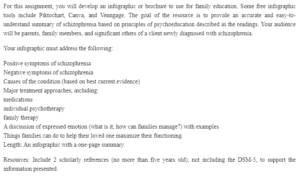Schizophrenia
Schizophrenia is a mental disorder that distorts emotions, thinking, perceptions, language and behavior (American Psychiatric Association (APA), 2013). It presents with negative and positive symptoms. The negative symptoms include lack of pleasure, trouble with speech, affective flattening, decreased verbal expression and avolition (APA, 2013). Several factors have been associated with the onset of schizophrenia. They include genetic predisposition, male gender, stressful events, and alcohol and drug abuse (Ganguly et al., 2018). The positive symptoms include hallucinations, delusions, movement disorders and disorganized speech (APA, 2013). Schizophrenia requires long-term management. It can be managed with antipsychotics to reduce the negative and positive symptoms. Individual therapy helps with positive coping skills, while family psychotherapy provides emotional support to caregivers (Burbach, 2018; Goff, 2020; Haram et al., 2019).
Expressed emotion is an adverse family environment that includes the nature of the family relationship between the schizophrenic patient and the caregivers. It also involves the quality of patterns of interactions. It is defined as the caregiver’s attitude toward a patient with schizophrenia, as revealed by comments (Cherry et al., 2018). It is a major stressor linked with the reoccurrence of the illness (Cherry et al., 2018). Components of expressed emotion include critical comments, positive remarks, warmth, and emotional overinvolvement (Cherry et al., 2018). Family-focused psychotherapy can help reduce EE by enhancing the caregiver’s knowledge of the disease. It can help clarify myths concerning schizophrenia and provide emotional support (Burbach, 2018).
There are several ways the family and caregivers can help their loved ones maximize their function. They include educating themselves on the cause and presentations of schizophrenia, listening to the patient’s problems, being empathetic and encouraging the patients to adhere to the prescribed treatment modalities.
References
American Psychiatric Association (APA). (2013). Diagnostic and statistical manual of mental disorders (DSM-5®). American Psychiatric Pub.
Burbach, F. R. (2018). Family therapy and schizophrenia: A brief theoretical overview and a framework for clinical practice. BJPsych Advances, 24(4), 225-234. https://doi.org/10.1192/bja.2017.32
Cherry, M. G., Taylor, P. J., Brown, S. L., & Sellwood, W. (2018). Attachment, mentalization and expressed emotion in carers of people with long-term mental health difficulties. BMC Psychiatry, 18(1). https://doi.org/10.1186/s12888-018-1842-4
Ganguly, P., Soliman, A., & Moustafa, A. A. (2018). Holistic management of schizophrenia symptoms using pharmacological and non-pharmacological treatment. Frontiers in Public Health, 6. https://doi.org/10.3389/fpubh.2018.00166
Goff, D. C. (2020). The pharmacologic treatment of schizophrenia—2021. JAMA, 325(2), 175-176. https://doi.org/10.1001/jama.2020.19048
Haram, A., Fosse, R., Jonsbu, E., & Hole, T. (2019). Impact of psychotherapy in psychosis: A retrospective case-control study. Frontiers in Psychiatry, 10. https://doi.org/10.3389/fpsyt.2019.00204
ORDER A PLAGIARISM-FREE PAPER HERE
We’ll write everything from scratch
Question 
For this assignment, you will develop an infographic or brochure to use for family education. Some free infographic tools include Piktochart, Canva, and Venngage. The goal of the resource is to provide an accurate and easy-to-understand summary of schizophrenia based on principles of psychoeducation described in the readings. Your audience will be parents, family members, and significant others of a client newly diagnosed with schizophrenia.

Schizophrenia
Your infographic must address the following:
Positive symptoms of schizophrenia
Negative symptoms of schizophrenia
Causes of the condition (based on best current evidence)
Major treatment approaches, including:
medications
individual psychotherapy
family therapy
A discussion of expressed emotion (what is it; how can families manage?) with examples
Things families can do to help their loved one maximize their functioning.
Length: An infographic with a one-page summary.
Resources: Include 2 scholarly references (no more than five years old), not including the DSM-5, to support the information presented.